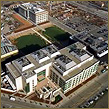
UCSF Mission Bay. Photo by Mark DeFeo
UCSF faculty and staff gathered Tuesday to officially begin the program planning process for clinical facilities at Mission Bay.
"We are clearly beginning a new era at UCSF," Mark Laret, chief executive officer of UCSF Medical Center, said to an audience of more than 100 people in Cole Hall.
Laret again joined David Kessler, dean of the UCSF School of Medicine and vice chancellor for medical affairs, to set the stage for the next phase of planning. The goal is to complete the programming and site planning phase by June 2005.
The long-term vision - to be phased in through 2030 -- is to operate two major research and clinical campuses, Mission Bay and Parnassus, each integrated with basic and clinical research, education and clinical care. Mount Zion will serve as an ambulatory care hub.
The first phase for new facilities at Mission Bay calls for building three contiguous hospitals with about 210 beds for women, children and cancer services and a major ambulatory translational research center for these clinical services, plus others in new research buildings for cardiovascular, cancer and neurosciences. The second phase involves building a new pavilion on Parnassus to replace Moffitt Hospital by 2030 and to expand the cancer hospital at Mission Bay in addition to increasing translational research and outpatient services.
"This is a historical time for UCSF," Laret said. "Very few people are privileged with an opportunity to think as big and as bold as we are planning to do here."
Both Laret and Kessler thanked faculty, staff and campus leaders for participating in the planning process thus far and encouraged ongoing cooperation as the campus forms working groups to look at specific program and space needs for women's, children's and cancer hospitals as well as translational research, ambulatory and support services.
Laret asked those who will be involved over the next few months to "think broadly" and to "think outside the box," emphasizing that "everything we do needs to have flexibility and future growth in mind" and "to be mindful of that fact that philanthropic support is essential."
Indeed, Ken Jones, chief financial officer of UCSF Medical Center, pointed out that UCSF will need to "beg, borrow and earn" its way to raise the estimated $1.7 billion needed over the next 10 years to complete the first phase of the plan. About $800 million of that amount includes construction, new equipment and information technology investments directed at the Mount Zion and Parnassus campuses, he said.
To accomplish this very ambitious project at Mission Bay, Jones continued, UCSF Medical Center will have to increase its inpatient bed capacity, stay profitable, borrow about $400 million, raise about $200 million in private support and invest in current facilities at Mount Zion and Parnassus Heights.
 |
| David Kessler
|
In outlining the academic vision for the plan, Kessler reiterated that while the focus will be on planning for the proposed clinical facilities for Mission Bay, UCSF will continue to invest in the other campuses as well. He particularly pointed out the importance and future role of UCSF's historic flagship campus at Parnassus Heights. (See video in either
QuickTime
or
Real format, or Download
QuickTime or
Real media players.)
To help lead the initial phases of planning, UCSF has hired Bruce Komiske to serve as executive director for clinical facilities development. Komiske, who worked on hospitals on the East Coast, said it is very critical to design spaces that use art, landscaping, gathering areas and the latest technology to comfort patients at a time when they experience the "heights and depths of their emotions."
Komiske will work with the campus community as well as SmithGroup, a San Francisco planning and architectural firm selected by UCSF to work on planning for programs to determine the designs of the Mission Bay clinical facilities. The SmithGroup team, introduced at the meeting on Tuesday, brings a wealth of experience in hospital planning and design. Among those leading SmithGroup for this project is Bill Diefenbach, a principal architect, who designed UCSF Genentech Hall at Mission Bay and the clinical cancer building at Mount Zion.
Over the next few months, a representative from SmithGroup and from UCSF will co-lead working groups formed for the women's hospital, children's hospital, cancer hospital, ambulatory care, translational research, diagnostic and treatment facilities and support services. Minutes from their meetings are posted on the
Mission Bay facilities program planning website.
While the impetus for building new hospitals was to comply with state seismic safety laws, which mandate that Mount Zion hospital be replaced by 2013 and Moffitt Hospital be replaced by 2030, Laret said that regardless of whether these deadlines are ultimately extended through legislation, UCSF will move forward with its plans. The main incentives to go forward, he pointed out, are that UCSF is determined to address the hospitals' functional obsolescence and to increase capacity to meet patient demand.
Stunning Progress
Bruce Spaulding, vice chancellor for University Advancement and Planning, recounted the stunning progress made to date in developing the 43-acre campus at Mission Bay. By month's end, UCSF will have three research buildings open: UCSF Genentech Hall, Arthur and Toni Rembe Rock Hall and the California Institute for Quantitative Biomedical Research or QB3 in addition to the Koret Quad.
This year alone, UCSF Mission Bay will open the Mission Bay Community Center and its adjacent parking structure this summer and the UCSF Mission Bay Housing Complex and Third Street parking structure by fall. Meanwhile, construction will begin on the Helen Diller Family Cancer Research building and surface parking.
Spaulding said meetings so far with the public on the proposed plans to expand UCSF's presence south of the current Mission Bay campus by another 10 acres for these clinical and translational research facilities have gone "remarkably smoothly." The next steps, Spaulding noted, are to execute a ground lease option with Catellus Development Corp., start discussions with two other land owners and resolve lost property tax issues with the San Francisco Redevelopment Agency and the City and County of San Francisco.
UCSF officials are expected to present the project proposal, which will amend the campus' current Long Range Development Plan, to the UC Board of Regents in March.
For their part, faculty and staff encouraged planners to consider allocating sufficient space for the education of health care professionals, incorporating principles of environmental sustainability and ensuring patient and employee safety and security in building designs, among other suggestions given at the end of the two-hour meeting.
PowerPoint presentations by Mark Laret, Bruce Spaulding, Ken Jones and Bruce Komiske are posted on the
Mission Bay Facilities Program Planning website.
Source: Lisa Cisneros
Related Links
Mission Bay Facilities Program Planning website
UCSF Officials Define Vision for Future Growth



